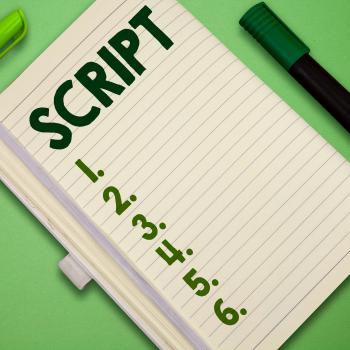Writing a Movie: Summarizing and Rereading a Film Script

- Preview |
- Standards |
- Resources & Preparation |
- Instructional Plan |
- Related Resources |
- Comments
Overview
Students are transformed into script writers in this lesson that develops skills in viewing, descriptive writing, and fluency. In this multisession lesson, students view a short film segment that has lots of action and little dialogue. While this lesson uses E.T.: The Extra-Terrestrial, the first 10 minutes of Indiana Jones and the Last Crusade or The Lion King will work nicely with this lesson. As students view the scene in increments, they describe the action of the film as the teacher records the sentences students dictate. After students have watched the scene in its entirety, they listen to a reading of their descriptions and work to improve descriptions and revise any inaccuracies. Students are then assigned parts of the script and perform a dramatic reading of the script as the movie plays in the background. Fluency is key in this lesson because students must match the timing of their reading with the images on the screen.
From Theory to Practice
Writing a Movie provides an opportunity for students to write a description of a film scene and then reread the description to prepare for a schoolwide performance. Students receive feedback on their reading from teachers, classmates, and members of the school community. The rereading takes place in an age-appropriate, purposeful manner and contributes to reading fluency.
Common Core Standards
This resource has been aligned to the Common Core State Standards for states in which they have been adopted. If a state does not appear in the drop-down, CCSS alignments are forthcoming.
State Standards
This lesson has been aligned to standards in the following states. If a state does not appear in the drop-down, standard alignments are not currently available for that state.
NCTE/IRA National Standards for the English Language Arts
- 4. Students adjust their use of spoken, written, and visual language (e.g., conventions, style, vocabulary) to communicate effectively with a variety of audiences and for different purposes.
- 5. Students employ a wide range of strategies as they write and use different writing process elements appropriately to communicate with different audiences for a variety of purposes.
- 6. Students apply knowledge of language structure, language conventions (e.g., spelling and punctuation), media techniques, figurative language, and genre to create, critique, and discuss print and nonprint texts.
Materials and Technology
- Computers with Internet access
- Smartboard or chart paper and markers
- VHS or DVD of E.T.: The Extra-Terrestrial directed by Steven Spielberg (Universal Studios, 1982)
- Word processing program
Printouts
Websites
Preparation
| 1. | In this lesson, students will write a summary for a brief segment of the film E.T.: The Extra-Terrestrial. To prepare for the lesson, watch the entire film in advance to familiarize yourself with the story. |
| 2. | There are many excellent websites offering background information and interactive activities for the film, E.T.: The Extra-Terrestrial. Visit the following websites to prepare for the lesson:
|
Student Objectives
Students will
- Write a description of a film segment
- Read a film description fluently
- Work in a cooperative learning situation
Session 1
| 1. | Begin by reminding the class that there are many ways to tell a story. Filmmakers tell a story with pictures. In this lesson, students will use visual images from a film and descriptive writing to tell a story. |
| 2. | Show the opening segment (first 8 to 10 minutes) of the film, E.T: The Extra-Terrestrial. In this segment, E.T. leaves his spaceship to gather plant specimens on earth. As humans approach, the spaceship leaves the earth and E.T. is left behind. Discuss these events with the class. Raise questions such as, "How did E.T. feel when he saw humans approaching? Why did the spaceship leave without E.T.?" |
| 3. | Rewind the videotape or DVD and show the first minute of the film. Ask students to describe the action and scenery of that segment. |
| 4. | As students describe the film, use a computer and word processing program to type the sentences they dictate. As you type, project the text from the computer screen onto a Smartboard or large monitor so that the class can read the dictated sentences as you type. An alternative method would be to record the sentences on large chart paper or on the chalkboard in a format similar to a language experience approach. [Note: In a language experience approach, students dictate sentences while the teacher writes their sentences on chart paper, on the chalkboard, or on a computer. The students' sentences are then used as reading material.] |
| 5. | Continue to watch portions of the film segment. After showing each portion, stop the videotape or DVD and ask students to describe the segment they have just seen. Type the sentences as the students dictate. At times, the students may offer sentences that clearly describe the scene. When a student's description is vague or confusing, ask probing questions to help clarify ideas. You may need to occasionally rewind the film, look at a scene again, and ask the entire group to help describe the scene more clearly. |
| 6. | You will find that students will want to frequently stop and start the videotape or DVD to clarify points and look for details in the film. Encourage this practice—it means that the students want to do a sincere, thorough analysis. |
| 7. | After you have watched the entire eight-minute segment and have written the script for those eight minutes, play the eight-minute segment again in its entirety. Read the script aloud as students watch the film. The class can then make revisions to sections where they feel the script does not match the film. |
| 8. | Print a copy of the script for each student. |
| 9. | Provide time for students to visit the film review of E.T.: The Extra-Terrestrial. This website contains a written summary of the film. Students can compare the script they wrote to the summary contained on the website. |
Session 2
| 1. | Review the previous lesson by showing the entire eight-minute segment. Then show the segment again and read the script as the segment is playing. This gives you an opportunity to serve as a model of fluent oral reading. |
| 2. | Divide the script and give each student a part to read. In large classes, you may wish to divide the students into groups so that every student has a part. |
| 3. | Ask students to work in pairs or small groups to practice reading their portion of the script. |
| 4. | Show the film segment again. Ask each student to read his or her part of the script at the appropriate point in the film segment. At first, students may have difficulty timing their reading with the action of the film. One student could serve as the film's director and signal each student when it is his or her turn to read. Students may need several rehearsals to pace their reading with the action of the film. This gives an authentic purpose for rereading and helps students develop fluency. |
Session 3
Invite your students to perform their oral reading for other classes in the school. Play the film segment on a large screen as students give a dramatic reading of their script. The opening eight-minute segment of E.T.: The Extra-Terrestrial includes background music that adds to the suspenseful feeling of the film. Let the original audio portion of the film play in the background as students read the parts they have written. The powerful music, exciting visual images, and expressive oral reading by your students will captivate the audience and may motivate other classes to replicate the project.
Extensions
- This lesson encourages students to view a film and write a descriptive summary. To extend the creative writing opportunity, invite students to visit the Universal Studios website for E.T.: The Extra-Terrestrial, select a picture from the site, and write a description of it.
- Have students access the Universal Studios website for E.T.: The Extra-Terrestrial to find facts about the making of the film. Students can gather facts from this website and write questions to quiz their classmates.
- Repeat this lesson using other highly visual adventure films, such as:
- The Lion King. Allers, R. & Minkoff, R. (Directors). (1994). The lion king [Motion picture]. United States: Disney Studios.
- The Wizard of Oz. Fleming, V. (Director). (1939). The wizard of Oz [Motion picture]. United States: Warner Studios.
- Annie. Houston, J. (Director). (1982). Annie [Motion picture]. United States: Columbia Tri-Star.
- Indiana Jones and the Last Crusade. Spielberg, S. (Director). (1989). Indiana Jones and the last crusade [Motion picture]. United States: Paramount Studio.
- The Lion King. Allers, R. & Minkoff, R. (Directors). (1994). The lion king [Motion picture]. United States: Disney Studios.
Student Assessment / Reflections
Student self-assessment. Writing a Movie provides an opportunity for students to work in a cooperative learning situation. Distribute the Rubric for Writing a Movie. Ask each student to reflect upon his or her participation in the activity and use the rubric to rate his or her performance. After completing the rubric, students should discuss their self-assessment with members of their group.
Teacher assessment. Assess the effectiveness of the lesson by asking the following questions:
- Did each student contribute at least one sentence to the film script?
- Was each student able to read his or her portion of the script fluently?
- Did students work cooperatively in their small groups to prepare for the performance?
- Were students able to use the Rubric for Writing a Movie to accurately evaluate their performance?
